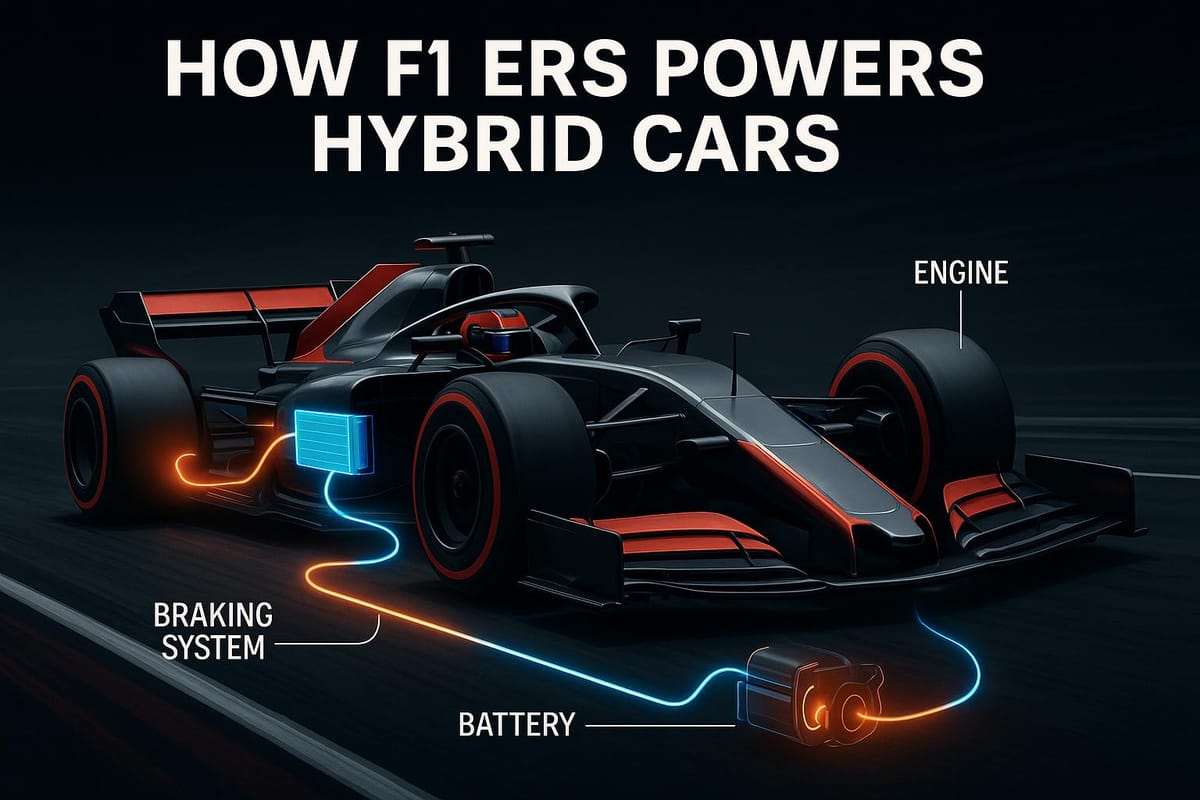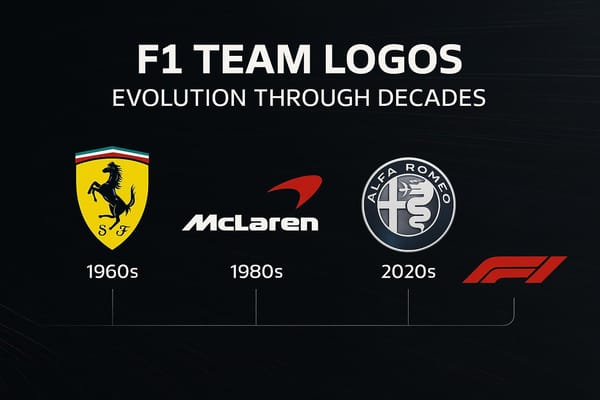How F1 ERS Powers Hybrid Cars
Explore how Formula 1's Energy Recovery System is revolutionizing hybrid car technology, enhancing performance and efficiency in everyday vehicles.

Formula 1's Energy Recovery System (ERS) is changing how hybrid cars work. Here’s what you need to know:
- What is ERS? It captures energy from braking (MGU-K) and exhaust heat (MGU-H) to boost power and efficiency.
- How does it help? It stores energy in batteries and adds up to 161 hp during acceleration, improving performance and fuel efficiency.
- Impact on hybrid cars: Regenerative braking and turbo heat recovery from F1 are now in everyday hybrids, making them more efficient.
- Future tech: Solid-state batteries could make hybrids even better with faster charging and more energy storage.
F1’s ERS isn’t just for racing - it’s shaping the next generation of hybrid cars.
This is how the hybrid system of a F1 engine works | RacingNews365

Main Parts of F1 Energy Recovery Systems
Formula 1's Energy Recovery System is a marvel of engineering, designed to capture, store, and reuse energy that would otherwise go to waste. It relies on three key components, each working in harmony to enhance the power unit's efficiency and performance.
MGU-K: Turning Braking into Power
The Motor Generator Unit-Kinetic (MGU-K) is mounted on the crankshaft and plays a pivotal role during braking. Instead of letting kinetic energy dissipate as heat, the MGU-K captures it and converts it into electrical energy. Think of it as a highly advanced version of the regenerative braking systems found in hybrid cars, but operating on a much larger scale.
This system isn’t just about energy recovery - it’s about delivering power when it’s needed most. The MGU-K can add up to 161 horsepower (120 kW) during acceleration, giving drivers a significant edge when exiting corners or overtaking. It’s a perfect blend of efficiency and performance, making every braking zone an opportunity to gain an advantage.
MGU-H: Harnessing Heat from Exhaust
The Motor Generator Unit-Heat (MGU-H) is all about making use of the heat energy produced by the turbocharger. Integrated directly into the turbo system, it serves two vital purposes:
- Recovering Energy: The exhaust gases spin the turbine, and the MGU-H converts that rotational energy into electricity.
- Turbocharger Control: It can also act as a motor, spinning the turbo to eliminate lag and improve engine responsiveness.
Unlike the MGU-K, the MGU-H works continuously throughout the lap, ensuring a steady stream of energy recovery and smoother power delivery. This constant operation helps maintain the overall efficiency of the power unit.
Battery Systems in F1
At the heart of the energy storage process is the Energy Store (ES), a sophisticated lithium-ion battery system. It acts as the intermediary, managing the flow of power between the MGU-K, MGU-H, and the engine. Here’s a quick look at its specs:
| Specification | Value |
|---|---|
| Maximum Energy Storage | 4 MJ (1.1 kWh) |
| Peak Output Power | 120 kW |
| Weight | Approximately 55 lbs (25 kg) |
| Operating Temperature | 140-176°F (60-80°C) |
This system is built to handle the extreme demands of F1 racing. It charges and discharges rapidly, balances power inputs from the MGU units, and ensures a steady flow of energy to maximize performance. All of this happens while maintaining safe operating temperatures, even under the intense conditions of a race.
Together, these components form the backbone of F1’s hybrid power units, blending cutting-edge technology with precision engineering to push the limits of what's possible on the track.
How ERS Works with F1 Engines
When it comes to Formula 1, the integration of the Energy Recovery System (ERS) with the engine is a game-changer. This setup combines the raw power of a traditional engine with the efficiency of electrical energy, creating a hybrid solution that pushes performance to new heights. It's not just about speed - it’s about smarter energy use and advanced power management.
Power Split: Engine and ERS
Modern F1 power units are all about teamwork - pairing the internal combustion engine with an electrical boost from the ERS for maximum output. The engine itself delivers a staggering 530 horsepower per liter, while the ERS, through the MGU-K system, adds another 161 horsepower to the mix. Together, these power sources create a dynamic duo that adapts to track conditions and race strategies.
Here’s a snapshot of how power is distributed in an F1 car:
| Power Source | Output | Contribution |
|---|---|---|
| Internal Combustion Engine | ~530 hp/liter | ~80% |
| ERS (MGU-K) | 161 hp | ~20% |
| Total Peak Power | ~750+ hp | 100% |
The combination is impressive, but it also demands precision. Each component has its own cooling system to keep temperatures in check, ensuring everything runs smoothly. With clearly defined roles for both the engine and the ERS, teams can focus on smart energy deployment during the race.
ERS Power Management
Managing ERS power is like playing chess at 200 mph. Teams constantly monitor energy levels, temperatures, and race conditions using tools like the 'Hybrid Energy System' graphic. This allows them to make quick decisions about when to harvest energy or unleash it for a performance boost. Here’s what they consider:
- Track position and race conditions: Timing is everything, especially for overtaking or defending.
- Energy availability: The Energy Store’s charge levels dictate how much power can be deployed.
- Temperature control: Overheating can cripple performance, so cooling systems are critical.
- Strategic opportunities: Whether it’s a critical overtake or maximizing speed on straightaways, deploying energy at the right moment is key.
The ERS doesn’t just add power - it delivers it instantly when it’s needed most. This precise management ensures that every ounce of energy is used efficiently, turning split-second decisions into race-winning advantages.
F1 ERS Impact on Regular Hybrid Cars
The cutting-edge Energy Recovery Systems (ERS) developed for Formula 1 are now making their way into the world of consumer hybrid vehicles. These advancements are changing the way hybrid cars capture and utilize energy, bringing a touch of race-day innovation to everyday driving.
Brake Energy Recovery
Inspired by F1 technology, modern hybrid cars use regenerative braking systems to convert motion into electrical energy. When the driver brakes, these systems capture the energy that would otherwise be lost as heat and store it in the car's battery. That stored energy can then be used to power the vehicle during acceleration or cruising, improving overall efficiency.
Turbo Heat Recovery
Another F1-inspired feature is turbo heat recovery. By repurposing the heat generated by the turbocharger, hybrid engines can deliver smoother performance and better fuel economy. This technology not only enhances engine responsiveness but also contributes to reducing fuel consumption.
These race-bred innovations are paving the way for more energy-efficient and eco-friendly vehicles, making sustainable mobility a reality for everyday drivers.
What's Next for ERS and Hybrid Cars
Energy Recovery Systems (ERS) in hybrid vehicles are on the verge of major advancements, thanks to cutting-edge energy storage technologies. These developments aim to push efficiency and performance to new heights, building on the foundation laid by F1-inspired innovations.
One of the most exciting advancements is the rise of solid-state batteries. These batteries promise higher energy density and quicker charging times compared to traditional lithium-ion options. By incorporating solid-state technology, hybrids could recover energy more effectively and deliver better overall performance. This leap in storage capability is poised to redefine how ERS functions in hybrid vehicles, paving the way for a more efficient and powerful driving experience.
Conclusion
Formula 1's advancements in Energy Recovery Systems (ERS) are reshaping the way modern hybrid vehicles combine performance with efficiency. These cutting-edge systems are no longer confined to the racetrack - they're influencing the cars we drive every day.
Take Williams Hybrid Power's technology, for example. Audi adopted it for Le Mans racing back in 2012, highlighting how F1's innovations can ripple across other racing formats and even into production vehicles.
The data speaks for itself: F1 power units have achieved impressive efficiency by seamlessly integrating combustion engines with electric power. This breakthrough has directly contributed to better performance and improved fuel economy in consumer hybrids. And it’s clear that this is just the beginning of what’s possible.
Looking ahead, advancements in high-energy density batteries and AI-driven power management systems are set to push the boundaries even further. Control electronics that optimize energy flow are already making everyday vehicles more capable and efficient.
As emissions regulations tighten, the technology honed under the extreme demands of F1 racing is poised to deliver solutions that balance environmental concerns with high performance. The relentless refinement of ERS systems ensures that hybrid vehicles will continue to evolve, offering drivers more reliable, efficient, and advanced technology in the years to come.
FAQs
How does the MGU-K in Formula 1's Energy Recovery System compare to regenerative braking in hybrid cars?
The MGU-K (Motor Generator Unit - Kinetic) in Formula 1's Energy Recovery System (ERS) and the regenerative braking systems in hybrid consumer cars share a common goal: capturing energy that would otherwise be wasted during braking and putting it to good use. But that's where the similarities end. The MGU-K is built for the intense demands of F1 racing, capable of recovering up to 120 kW of energy. This energy isn't just stored - it’s strategically used to deliver extra power or improve efficiency during a race, giving drivers a competitive edge.
In contrast, regenerative braking in hybrid consumer vehicles focuses on efficiency and fuel savings. These systems recover smaller amounts of energy, primarily to recharge the battery and reduce fuel consumption. While both systems operate on the same principle, the technology in F1 takes energy recovery to an entirely different level, showcasing what’s possible when performance is the top priority.
How does Formula 1's Energy Recovery System (ERS) contribute to hybrid car technology?
Formula 1's Energy Recovery System (ERS) is a game-changer in hybrid car technology, capturing and reusing energy that would otherwise go to waste. In F1, the ERS harnesses two key energy sources: kinetic energy generated during braking and thermal energy from the exhaust. This energy is then converted into electric power, giving cars an extra performance boost while also improving fuel efficiency. It's all part of the hybrid power unit, which seamlessly combines power and efficiency.
What makes this even more exciting is how F1's ERS technology has shaped the hybrid cars we drive today. Features like regenerative braking and advanced energy storage systems in modern hybrids trace their roots back to F1 innovations. These advancements have made everyday cars more efficient and environmentally friendly, all while maintaining impressive performance.
How do Formula 1 teams use ERS to balance speed and energy efficiency during a race?
Formula 1 teams use the Energy Recovery System (ERS) as a key tool to enhance both speed and efficiency on the track. The ERS captures energy during braking and from the turbocharger, storing it in a battery. This stored energy can then be unleashed to provide an extra power boost, whether it's for overtaking rivals or holding off challengers.
Teams rely on advanced algorithms to monitor energy levels and determine the optimal moments to deploy ERS power. Drivers also have the ability to tweak ERS settings directly from their steering wheel, making split-second tactical choices. Whether it's saving energy for crucial parts of the race or going all-in to seize an opportunity, ERS plays a pivotal role in race strategy.




